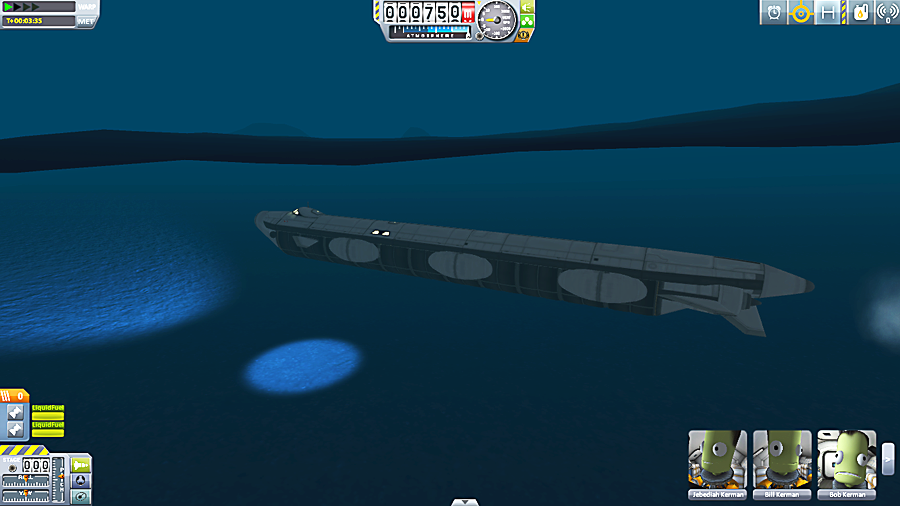

Like all other atmospheres in the game, Laythe's atmosphere fades exponentially as altitude increases. These values suggest a compostion very similar to Kerbin, and to Earth - likely nitrogen and oxygen. The average molecular weight of Laythe air is 28.9644 g/mol, and its adiabatic index is 1.40.

Laythe is the only moon in the game that has an atmosphere. The atmosphere contains oxygen ,can support combustion and is breathable by Kerbals. The sea level pressure on Laythe is equivalent to that at an altitude of 3,287 m on Kerbin. Compared to the atmosphere of Kerbin, Laythe's atmosphere has 1/2 the mass and 3/5 ths the surface pressure. The atmosphere has a mass of approximately 2.4×10 16 kilograms, a sea level pressure of 60.795 kilopascals (0.6 atmospheres), and a depth of 50,000 meters. Laythe has an atmosphere thick enough and warm enough to support liquid water on its surface. Temperature and pressure of Laythe's atmosphere as a function of altitude.


It is therefore possible that there are also high concentrations of salt in the air, as well as on the surface, assuming that the salt is sodium chloride. The air, however, does have a strange smell about it. According to EVA reports, the air can be breathed by Kerbals. Surface samples indicate that much salt is present on Laythe's surface. This means Laythe's oceans must contain another compound which reduces its freezing point, most likely ionic, such as salt. Instead, Laythe's liquid ocean and dense atmosphere invite comparison with the Saturnian moon Titan, but Laythe is 3 times warmer in absolute temperature.Īlthough Laythe has liquid water on its surface, its polar regions have temperatures below zero degrees Celsius even outside its ice caps. But while Tylo and Vall have a certain resemblance to their real-life counterparts, Laythe is very unlike Io, which is dry, volcanic, and only has a tenuous atmosphere. In the real-world Jupiter system, the moons Ganymede, Europa and Io form a group with an orbital resonance just like KSP's Tylo, Vall and Laythe. A circular archipelago prominent in surface maps of the moon suggests that Laythe suffered a massive impact in its distant past.Īchieving a stable orbit around Laythe from sea level requires a delta-V of ≈2900 m/s. Synchronous orbits around Laythe are not possible, as they would lie outside of its SOI, at a radius of 5,186,399 meters. Although mostly covered in seas, Laythe has numerous rocky, sandy islands. Laythe is the innermost of the five natural satellites of Jool. ↑ 1.0 1.1 1.2 1.3 The distances are given from the body's center, not from the surface (unlike ingame).There are four distinct Basins and Poles available as well. It has mostly large Lowlands broken up by Midlands and Highlands with some high Mountains in between. When terrain scatters are activated, large boulders with contrast-rich black and white surface patterns can be found on the surface. The surface color ranges between white and light blue. Vall has some circular mountain ridges which could be remnants of impact craters, but they are heavily eroded, hinting that Vall has some geological activity, presumably in the form of cryovolcanism. There are almost no completely level areas, making it hard to find good landing spots. Vall has an icy surface dominated by hilly lowland areas separated by mountain ridges and which ranges in elevation from 0 to 7976 m. finally decided to just tell them it was an actual object in the sky. Eventually after a rash of returned telescopes, Advanced Optics Co. Frustrated scientists kept attempting to wipe it off the lenses of their telescopes. Vall was one of the last Moons of Jool to be discovered. Though the bodies have topical similarities, landing on Vall and returning is significantly more challenging than a landing on the Mün, due to the former's higher gravity, more uneven terrain and distance from Kerbin.Īccording to former developer NovaSilisko, Vall was planned to be made more like Eeloo, with cracks in the ice and a more chaotic surface than in 0.20.2. Perhaps Vall is subject to less tidal heating, but still enough for the ice to have some plasticity and for small-scale cryovolcanism. However, it has considerably greater surface relief, suggesting different internal structures or processes. Also like Europa, it is remarkably crater-free. Vall occupies a comparable orbital position Jupiter's moon Europa. Synchronous orbits around Vall are not possible, as they would lie outside of its SOI, at a radius of 3,893,254 meters. Like the other large Joolian moons, Laythe and Tylo (of which Vall is the smallest), Vall is tidally locked to its parent. Vall is the second of the five natural satellites of Jool.


 0 kommentar(er)
0 kommentar(er)
